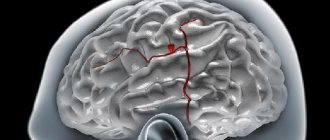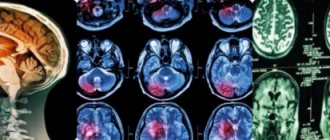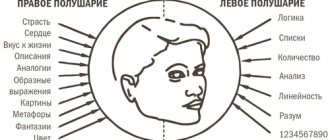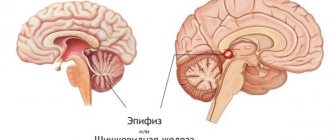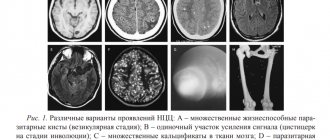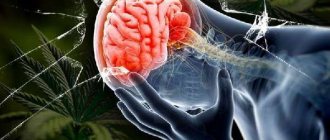Introductory part
Exam questions:
1.24. The structure of the cerebral cortex, cyto-, myelo-, angioarchitectonics. Dynamic localization of functions in the cerebral cortex, 1-area, 2-area, 3-area cortical fields.
1.25. Sensorimotor zone of the cerebral cortex: structure, symptoms of damage.
1.29. Analyzers of the II signal system: anatomy, physiology, symptoms of damage.
1.30. Symptoms of damage to the frontal and temporal lobes. Types of aphasia.
1.32. Symptoms of damage to the occipital and parietal lobes
Practical skills:
1. Taking anamnesis in patients with diseases of the nervous system.
5. Study of speech, praxis, gnosis
Cytoarchitecture and myeloarchitecture of the cerebral cortex
The cerebral cortex is represented by a layer of gray matter with an average thickness of about 3 mm (1.3-4.5 mm), the grooves and convolutions significantly increase the area of the gray matter of the brain. The cortex contains about 10-14 billion nerve cells. Its various sections, which differ from each other in certain features of the location and structure of cells (cytoarchitectonics), the arrangement of fibers (myeloarchitectonics) and functional significance, are called Brodmann's fields; there are no sharply defined boundaries between them.
1. Histological types of cortex:
- new cortex (lat. neocortex) - 6 layers, most of the cerebral cortex:
1) agranular type of cortex - in the motor centers of the cortex (for example, in the anterior central gyrus), layers III, V and VI are highly developed and layers II and IV are poorly expressed.
2) granular type of cortex - in the sensitive centers of the cortex (for example, visual), layers III, V and VI are poorly developed, granular layers (II and IV) reach their maximum development.
- old cortex (lat. archipallium) - 3 layers, the hippocampus, located in the depths of the hippocampal sulcus, and the dentate gyrus;
- ancient cortex (lat. paleopallium) - 2 layers, lower-inner surface of the temporal lobe (olfactory tubercle and the surrounding cortex, including a section of the anterior perforated substance);
- intermediate cortex (lat. mesocortex) - mixed structure, divided into two zones: one separates the new cortex from the old (peri-archicortical zone), the other from the ancient (peripaleocortical zone). These areas occupy the inferior insula, the parahippocampal gyrus, and the inferior limbic region.
2. The structure of the layers of the new cortex:
- 1st layer - molecular (lat. lamina molecularis) - small associative cells of a spindle shape, axons - parallel to the surface of the brain as part of the tangential plexus of the molecular layer (branching of the dendrites of the neurons of the underlying layers).
- layer 2 - external granular (lat. lamina granularis externa) - small neurons (10 µm), having a round, angular and pyramidal shape, and stellate neurons; dendrites - into the molecular layer; axons - in layers 3, 5 and 6.
- layer 3 - pyramidal neurons (lat. lamina pyramidalis) - the widest layer, pyramidal cells; the main dendrite is in the molecular layer, other dendrites are synapses with the cells of this layer; axon in small cells - within the cortex; large cell axon - forms myelin association or commissural fiber.
- layer 4 - internal granular (lat. lamina granularis interna) - small sensory stellate neurons and tangential plexus of the internal granular layer , developed very strongly in the visual zone of the cortex, practically absent in the precentral gyrus, dendrites - as part of the projection and commissural tracts, axons - in 3, 5 and 6 layers.
- layer 5 - ganglion (layer of Betz cells) (lat. lamina ganglionaris) - large pyramidal cells (in the precentral gyrus - giant pyramids of Betz), the main dendrite is from the molecular layer, the remaining dendrites are within the layer, forming a tangential plexus of the ganglion layer , the axon forms commissural and projection pathways.
- 6th layer - multiform (polymorphic) cells (lat. lamina multiformis) - neurons of various, mainly spindle-shaped, dendrites - from the molecular layer, axons - as part of commissural and projection pathways
3. General principles of the functioning of the cortex:
- afferent information along thalamo-cortical fibers -> cells of layer IV -> pyramidal cells of layers III and V,
— cells of layer III form fibers (associative and commissural) that connect different parts of the cortex.
— cells of layers V and VI form projection fibers to other parts of the central nervous system.
— in all layers of the cortex there are inhibitory neurons that play the role of a filter by blocking pyramidal neurons.
4. General principles of the brain center structure:
— “Nucleus” – a morphologically homogeneous group of cells with an accurate projection of receptor fields;
— “Scattered elements” – cells and groups of cells located outside the “nucleus” and carrying out elementary analysis and synthesis.
5. Areas of the cerebral cortex:
— Primary – projection zones (sensitive and motor), responsible for elementary acts,
— Secondary – projection-associative zones responsible for the operations of gnosis and praxis,
— Tertiary – associative-integrative zones, overlap of cortical representations of various analyzers.
6. Functional blocks of the cortex (according to A.R. Luria):
– energetic – regulation of cortical tone (limbic-reticular complex),
- receiving, processing and storing information (occipital, parietal and temporal cortex),
- programming, regulation and control (frontal lobes).
7. Integrative levels of the nervous system:
— The first signaling system is a system of conditioned reflex connections formed in the cerebral cortex of animals and humans when exposed to specific stimuli (light, sound, pain, etc.), is a form of direct reflection of reality in the form of sensations and perceptions.
— The second signaling system is a system of conditioned reflex connections formed in the cerebral cortex, in which an abstract conventional sign (word) produces a specific effect of the objects or actions it denotes. The key link is speech, which is achieved through the formation of a conditioned reflex connection between the word and the first-signal (specific) reaction.
Meninges of the brain
The brain, like the spinal cord, is covered with three membranes: soft, arachnoid and hard.
The soft, or vascular, membrane of the brain (lat. pia mater encephali) is directly adjacent to the substance of the brain, extends into all grooves, and covers all convolutions. It consists of loose connective tissue, in which numerous blood vessels branch that feed the brain. Thin processes of connective tissue extend from the choroid and penetrate into the mass of the brain.
The arachnoid membrane of the brain (lat. arachnoidea encephali) is thin, translucent, and has no blood vessels. It fits tightly to the convolutions of the brain, but does not extend into the grooves, as a result of which subarachnoid cisterns are formed between the choroid and arachnoid membranes, filled with cerebrospinal fluid, due to which the arachnoid membrane is nourished. The largest, cerebelloblongata cistern, is located behind the fourth ventricle, into which the median foramen of the fourth ventricle opens; the cistern of the lateral fossa lies in the lateral sulcus of the cerebrum; interpeduncular - between the cerebral peduncles; cistern crossroads - at the site of the visual chiasm (crossroads).
The dura mater of the brain (lat. dura mater encephali) is the periosteum for the inner cerebral surface of the skull bones. This membrane contains the highest concentration of pain receptors in the human body, while the brain itself has no pain receptors (see Headache
).
The dura mater is built of dense connective tissue, lined from the inside with flat, moist cells, and tightly fuses with the bones of the skull in the area of its internal base. Between the hard and arachnoid membranes there is a subdural space filled with serous fluid.
Higher cortical functions: research methods and disorders
Higher nervous activity is the neurophysiological processes that take place in the cerebral cortex and the subcortex closest to it and determine the implementation of mental functions.
1. Gnosis (recognition) - a stock of information about the world around us with constant comparison of them with the memory matrix.
— Research methods:
1) visual gnosis:
- recognition of real objects (pictures with objects),
— recognition of contour images (contours of objects),
— recognition of noisy figures (crossed out figures, superimposed images),
2) auditory gnosis:
- recognition of auditory rhythms (number of beats [2, 3, 4 beats], tempo [fast and slow]),
— reproduction of auditory rhythms (repeat the rhythm after the researcher [2 strong + 3 weak])
- recognition of everyday noises (dog barking, paper rustling).
3) spatial gnosis:
- recognition of letters and numbers (with noise and mirrored ones),
— time recognition (using a clock without numbers)
— Violations of gnosis:
1) Agnosia - a violation of recognition processes while maintaining sensitivity and consciousness:
- total agnosia - complete disorientation of a person,
- visual agnosia - impaired recognition of objects during visual perception - anterior parts of the occipital lobe (field 19),
- auditory agnosia - impaired recognition of objects by the noise they produce - Heschl’s superior temporal gyrus (field 42),
- gustatory and olfactory agnosia - impaired recognition of objects by taste and smell - insula (field 13, 14, 15, 16) ,
- spatial agnosia - impaired recognition of objects upon contact (astereognosis) - superior parietal lobule (field 5, 7),
- anosognosia - denial of the disease with an obvious defect - and autotopagnosia - violation of the body diagram, ignoring individual parts - angular gyrus of the subdominant hemisphere (field 39)
2) Distortions of perception:
- illusion - a distorted perception of a really existing object or phenomenon
— pareidolia — the formation of illusory images, the basis of which are the details of a real object
- hallucination - an image that appears in consciousness, without an external stimulus, in which an imaginary perceived object or phenomenon is located in objective mental space and is perceived by a specific sensory organ ( true , for example, taste or visual), or in subjective mental space, that is, perceived objects are not projected outward, are not identified with real objects ( false, pseudo-hallucination ).
2. Praxis (purposeful action) - the ability to perform successive complexes of conscious voluntary movements and perform purposeful actions according to a plan developed by individual practice.
— Research methods:
1) kinesthetic praxis:
- reproduction of a pose according to a visual model (poses are shown: index finger (fingers clenched into a fist), little finger (fingers clenched into a fist), rings of fingers (1 and 2, 1 and 3, 1 and 4, 1 and 5), index and middle finger (“victory”), index and little fingers (“unity”)),
- reproducing the pose according to a kinesthetic model (putting your fingers together with your eyes closed, “smoothing” your palm and asking you to repeat the pose)
2) spatial praxis (Head's tests):
- reproduction of a pose according to a visual model (straight hand in front of the chest with the palm up or down, straight hand under the chin with the palm down, straight hand under the nose with the palm down, vertical hand under the chin, vertical hand in front of the nose, right hand on the left shoulder, right hand behind the left ear).
3) dynamic praxis:
- repetition of poses according to a visual model (fist-rib-palm, drawing),
- reciprocal hand coordination (right - fist, left - palm, then vice versa)
4) ideation praxis :
- everyday poses (show lighting a cigarette, opening with a key, lighting a match)
- Apraxia - violation of focus and action plan:
1) spatial (constructive) apraxia - violation of spatial representations: right-left, top-bottom, difficulties in performing spatially oriented movements - angular gyrus of the dominant hemisphere (field 39),
2) dynamic (motor) apraxia - violation of the sequence and smoothness of movement - supramarginal gyrus of the dominant hemisphere (field 40),
3) ideational apraxia - a violation of the initiation of movements (but performs them by imitation) - field 39 and 40 of the dominant hemisphere + anterior parts of the frontal lobes.
3. Thinking is the process of reflection and cognition of essential connections and relationships of objects and phenomena of the objective world; the ability to formulate concepts, judgments and generalizations, logical operations with verbal and visual-figurative-sensory images of objects.
— Methods of thinking and methods of researching thinking
1) Analysis - dividing an object/phenomenon into its component components, synthesis - combining those separated by analysis while identifying significant connections, and comparison - comparing objects and phenomena, revealing their similarities and differences - comparing 8-10 pairs of words for commonalities and differences
2) Generalization - combining objects according to common essential characteristics, and concretization - isolating the particular from the general - “four extra”.
3) Abstraction - highlighting one aspect of an object or phenomenon while ignoring others - explanation of proverbs (“carry water in a sieve”)
— Mental retardation is a lag in mental development from one’s age while maintaining the ability to learn at a high level (with pedagogical and social neglect).
- Oligophrenia - a disorder of mental development with limited learning ability:
1) debility - maintaining adequate mental development at the everyday, everyday level,
2) imbecility - preservation of primitive motor acts and self-care skills,
3) idiocy - complete lack of speech and social maladjustment.
4. Memory is the ability to store information about events in the external world and the body’s reactions for a long time, accumulate, reproduce it many times to organize subsequent activities, and destroy information. There are mechanical and semantic memory; it consists of memorization (fixation of material), storage, recall (reproduction of material) and forgetting.
— Research methods:
1) visual memory (test 6 figures),
2) auditory memory (test 10 words),
3) spatial memory.
— Memory disorders
1) amnesia (hypomnesia) – memory loss – retrograde (for events before damage), anterograde (after damage),
2) hypermnesia - increased mechanical memory,
3) paramnesia - false memories; a mixture of past and present, as well as real and fictional events.
- confabulation - hallucination of memories, fictitious events that never took place in the patient’s life.
- pseudo-reminiscence - an illusion of memory, consisting in a displacement in time of events that actually took place in the patient’s life; the past is presented as the present.
4) sensations of “already seen” (déjà vu) or “never seen” (jema vu).
5. Speech - the use of language means to communicate with other members of the language community, the process of speaking and perception (speech activity), as well as its result (speech works recorded in memory or writing).
— Research methods:
1) nominative speech (naming objects around)
2) understanding speech (following simple and complex instructions)
3) reflected speech (repetition of sounds, words, simple sentences)
4) grammatical speech (understanding of logical constructions such as “father’s brother” and “brother’s father”)
— Speech disorders due to organic damage to the cerebral cortex:
1) Aphasia - decay of speech components with damage to cortical speech areas,
— Wernicke’s sensory aphasia – impaired understanding of oral speech, with a secondary impairment of expressive speech (cortical) [due to impaired control over one’s own speech] or without it (subcortical) – middle sections of the superior temporal gyrus of the dominant hemisphere (field 22)
1) a large number of unnecessary words , logorrhea (excessive talkativeness),
2) paraphasia (inaccurate use of words) and perseveration (monosyllabic answers to questions of different meanings)
3) with alexia (reading impairment) and agraphia (writing impairment) - cortical, and without alexia - subcortical.
- Broca's efferent motor aphasia - a combination of impairment of expressive oral speech and written speech (cortical) or only oral (subcortical) while maintaining its understanding - posterior parts of the inferior frontal gyrus of the dominant hemisphere (field 44)
1) inability to pronounce words, verbal embolus (“mu-mu” instead of any word)
- Afferent motor aphasia - impaired ability to repeat words aloud, as well as read aloud with less impaired active voluntary speech and understanding of spoken speech - the lower parts of the parietal lobe of the dominant hemisphere (damage to the connections of Wernicke's and Broca's centers).
1) literal paraphasia (rearrangement and omission of individual sounds),
2) verbal paraphasia (replacement of one word with another, similar in articulation, but different in meaning),
3) agramatisms (violations of the grammatical structure of speech).
- Acoustic-mnestic (amnestic) aphasia - while maintaining the understanding and reproduction of speech and the grammatical structure of phrases, verbal memory , difficulty in selecting the right words arises due to a decrease in vocabulary, the hint of the first syllable does not help - temporo-parietal junction (field 37).
- Optical-mnestic (amnestic) aphasia - while maintaining the understanding and reproduction of speech and the grammatical structure of phrases, verbal memory , difficulty in selecting the right words arises due to the separation of the image and the word (“what they drink from”), the hint of the first syllable helps - temporo-parietal junction (field 37).
- Semantic aphasia - violation of the grammatical logic of speech - angular gyrus of the dominant hemisphere (field 39)
— Dynamic aphasia (apraxia of speech) – retardation, poverty of speech, absence of spontaneous voluntary speech
2) Aprosodia – no perception of speech intonation while maintaining verbal information – field 22 of the subdominant hemisphere (analogous to Wernicke’s area) ,
3) Alalia – systemic underdevelopment of speech with damage to cortical speech zones in the pre-speech period (up to 2-3 years):
- Sensory alalia - impaired understanding of spoken speech while hearing is preserved (lack of speech vocabulary), motor speech is necessarily impaired,
— Motor alalia — underdevelopment of motor speech while maintaining understanding of spoken speech.
4) Agraphia - a violation of written speech - the angular gyrus of the dominant hemisphere (field 39) or with damage to the posterior part of the second frontal gyrus,
5) Alexia – reading disorder – angular gyrus of the dominant hemisphere (field 39),
6) Acalculia - violation of oral counting - angular gyrus of the dominant hemisphere (field 39),
— Acquired and congenital defects in the structure of the articulatory apparatus (NOT CORTIQUE):
1) Dysarthria - impaired pronunciation due to insufficient innervation of the vocal apparatus (“porridge in the mouth”), and nasolalia - due to impaired innervation of the soft palate (“nasal voice”)
2) Dyslalia - a violation of sound pronunciation with normal hearing and intact innervation of the articulatory apparatus.
— Functional brain disorders:
1) Stuttering - logoneurosis, a violation of the tempo-rhythmic organization of speech, caused by a convulsive state of the muscles of the speech apparatus,
2) Mutism and surdomutism - complete lack of contact or deaf-muteness of a functional nature
Physiology of nervous activity
(A brief summary of the physiology of higher nervous activity with my comments)
I.P. Pavlov on adaptation and the state of physiology
More than all the scientists in the world, I value I.P. Pavlova (1849–1936). And I read his works tirelessly, marveling at the power of his foresight, the integrity of his thinking, the highest morality and deep religiosity.
Regarding the adaptation process, he wrote this: “As a part of nature, each animal organism is a complex isolated system, the internal forces of which are balanced every moment, as long as it exists as such, with the external forces of the environment. The more complex the organism, the more subtle, numerous and varied the balancing elements. For this purpose, analyzers and mechanisms of both permanent and temporary connections are used, establishing the most precise relationships between the smallest elements of the external world and the subtlest reactions of the animal organism. Thus, all life, from the simplest to the most complex organisms, including, of course, humans, is a long series of increasingly complex balancing of the external environment to the highest degree. The time will come, however distant, when mathematical analysis, based on natural scientific analysis, will embrace all these balancings with majestic formulas of equations, finally including itself in them.”
I will add: organisms are both isolated from the outside world and connected with it – its structures and systems. The idea of the external world as a system with its own laws is characteristic of every animal organism. But a person can more accurately anticipate changes in the external system. With the power of the created technology, he can study the external system, protect himself from its extreme influences, strengthen weak links in time (this is “if I had known in advance, I would have laid a straw”), and restore the damaged structures of his body.
I.P. Pavlov wrote about the state of the physiology of the nervous system: “What does the facts currently available to physiologists regarding the cerebral hemispheres explain to us in the behavior of higher animals? Where is the general scheme of higher nervous activity? Where are the general rules for this activity? Modern physiologists stand before these most legitimate questions truly empty-handed” (Pavlov I.P. Twenty years of experience in the objective study of higher nervous activity (animal behavior). L., 1938. P.19).
This is still the case and not otherwise. I study what he once pointed out: blood circulation and the nervous system. How sad it is for me that he died of cholelithiasis! What a pity that I can’t help him...

